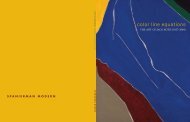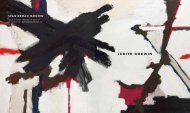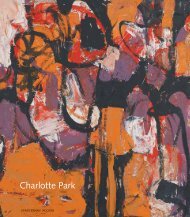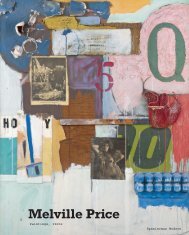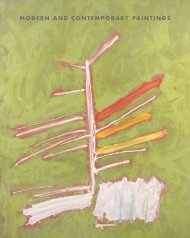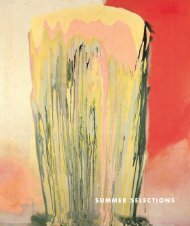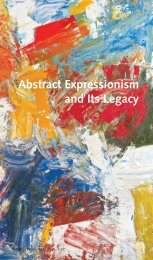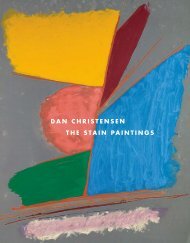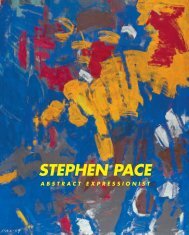BROCHURE (pdf) - Spanierman Modern
BROCHURE (pdf) - Spanierman Modern
BROCHURE (pdf) - Spanierman Modern
You also want an ePaper? Increase the reach of your titles
YUMPU automatically turns print PDFs into web optimized ePapers that Google loves.
stanley boxer
Brioderiesfromadark 1990 oil and Mixed media on canvas 30 x 48 in.january 19 to february 18, 2012SPANIERMAN MODERN53 EAST 58TH STREET new york, ny 10022-1617 tel (212) 832-1400bac@spanierman.comwww.spaniermanmodern.com
Still Life in an Interior 1960 Oil on canvas 56 1 ⁄ 2 x 55 1 ⁄ 2 in.
Autumnal brown gesture 1969 oil and collage on canvas 60 x 50 in.
Stanley Boxer (1926–2000), whose work is in numerousmuseum collections in America and abroad, worked withindefatigable energy during a career that spanned the secondhalf of the twentieth century. Throughout this time, Boxer’spaintings, sculpture, prints (woodblocks and monoprints),and drawings consistently received rave reviews fromthe press. In their extensive coverage, the critics almostinvariably proclaimed each new phase of Boxer’s art to behis best. Whereas many artists’ oeuvres are uneven, Boxersustained a trajectory of novelty and vitality. That he did sostemmed from his working method, in which he kept up anunXagging active and engaged physical involvement in thecreative process.After an early Cubist-Picasso inspired period in the late1940s, Boxer developed an approach that stemmed from theaction painting techniques of Abstract Expressionism andthe optical color sensations and allover approach of ColorField painting. However, he was not ideologically weddedto either aesthetic and combined elements of both at will.Noting his independence, critics have described him as“his own man,” 1 whose “pictures were about seeminglyirreconcilable oppositions,” 2 as an artist “with a grittydisregard for conventional approaches to any medium,” 3as one who “eschewed” schools and retained a uniqueand personal vision, 4 and as a “painter’s painter”; his workwas admired by artists working in many diVerent stylisticmodes. 5 If Boxer’s art can be situated, it would be best tosee it as emanating generally from a painterly traditionstretching back to the old masters. Karen Wilkin has statedthat Boxer culled from “a whole lexicon of time-honoredpainterly qualities—chiaroscuro, sfumata, alla prima texture—into the service of a twentieth-century taste for sparsenessand economy.” 6 While recalling Baroque opulence, Boxer’swork is tempered by modernist restraint and authenticity.In an era when many painters chose to work in acrylic,Boxer was dedicated to a use of oil, which he applied in arich and generous textural impasto. He has often been calleda “sculptor of paint.” Over time, he added collage elements tohis canvases, including such diverse materials as sand, gravel,pebbles, seeds, cork, glitter, roof shingles, and string. Hispassion was for surface vibrancy, in which color, texture, andform work together in a purposeful progression, engagingthe viewer often in an energetic momentum that buildsand develops. The surfaces of his paintings are never still.In their animate qualities, Boxer’s canvases evokeassociations with the natural world without being speciWcallyreferential. As one critic noted, his imagery was basedmore on remembered perceptions of nature than on hisobservations, capturing such qualities as “the feeling of theseasons, recalling the pale heathers and greens of spring,the snowy brightness of winter, the deep purple shadows ofsummer.” 7 Boxer’s images are also often map-like, conveyingsuggestions of landforms, water, and sky, while collagedelements add a topographical and relief dimension to thelater works. In naming his paintings, Boxer’s usual practicewas to string together words. The unbroken titles createa rhythmic complement to his paintings and parallel thecontinuous yet changing cadences of his surfaces as well astheir many associations.Boxer’s paintings reside within a modernist awarenessof the integrity of the surface, but they also demonstratea postmodernist humility. Neither full of existential angstnor stretching for sublime revelation, they express a loveof the sensuous, both in their textural aspects and in theirevocations of the natural world.Among the earliest examples in the show is Still Lifein an Interior (1960). The entirety of this almost-square,densely worked canvas comes alive for the viewer throughits variegated surface, consisting of some areas that arethickly painted with brushy strokes, others in which thepaint is bled into the canvas, and still others in which thebare canvas is exposed. In an upper section of the canvas,the quickened tempo created by rapid strokes loaded witha mix of colors imply elevation change, while vertical
indentations—some more obvious than others—evokecanyons and waterways. The painting seems predominantlyof a close-valued, burnished gold, but further observationreveals a myriad of tonal nuances. These are created toa large extent by Boxer through a use of underpainting,which shines through the top layer, producing light. As inImpressionist images, the painting seems to glow, conveyingthat its subject is reXected light.Autumnal Brown Gesture (1969) is in the Color Fieldidiom. Fabric that has been stained purple is collaged acrossmuch of the canvas. Against the translucent surface, shadowsand light seem to shift, while areas of the fabric that arecut into or collaged over create a sense of movement, as ifthrough the varied pathways of a garden. A blue and greenpartly collaged, partly painted shape at the center of thework provides a point of rest, but one that does not impedethe viewer’s sense of open possibilities.The exhibition includes many of the exuberant worksBoxer created in the 1990s, in which he blended oil paintwith a range of unusual materials. Some of these canvasesare so densely built up as to verge on relief sculpture. At thesame time, they reveal a painterly sensibility in their gesturaland calligraphic aspects. In Somewhereamarbleman (1990),yellow paint dripped and spread in Pollock fashion over anorange ground, moves the viewer along its diagonal edgeat the left, where the Wery orange ground emerges. Thenthe topography changes again, as tiny green rocks emulate aforest seen from above. The theme of the work seems to betransitioning, and it thus can read metaphorically.Broideriesfromadark (1990) brings together the alloversurface of a Color Field painting with a delight in puresensuousness, produced by the combination of glitter, sand,jewel-like painted rocks, and dabs of bright color. At the sametime, the overt decorative aspect of this painting demonstratesBoxer’s postmodern sensibility. In Paradisicalsuccors (1990),the upper half of the canvas is covered in red rocks of variedshapes and sizes, some colored and some painted over. TheParadisicalsuccors 1990 oil and Mixed media on canvas 26 3 ⁄ 4 x 13 5 ⁄ 8 in.
eVect from a distance is still that of a painting rather thana sculpture, as Boxer creates a sense of atmosphere in theshifting tonalities of the rocks. Ribbon-like lines extendthrough the rocks and down through the aqueous zone inthe work’s lower half, creating a sense of movement andexploration, like a voyager forging a path through unchartedterrain. In Lostnight (1997), Boxer made use of even moreunusual materials. Wood shavings, sawdust, dyed corrugatedcardboard, and roof shingles are blended into an image thatevokes the age-old theme in art of the transition betweenday and night, an allegorical reference to the thresholdbetween this life and one beyond.In the 1960s, Boxer’s work was discovered by thenoted critic Clement Greenberg, who categorized him asa Color Field painter. To Boxer, this label was too limiting.He stated in 1972: “Nothing is per se rejected in my work!Everything is possible.” 8 This sense of being open to lifein all of its richness, opportunities, and contradictions isstrongly present in his art. It is therefore not surprising thatcritics from all persuasions have expressed a deep regardfor Boxer and his work.Lisa N. Petersnotes1. Joy Hakanson Colby, “Stanley Boxer,” Detroit News, May 8, 1997.2. Karen Wilkin, Stanley Boxer: Recent Paintings,” exh. cat. (New York:André Emmerich Gallery, 1982).3. Doug Hanson, “Stanley Boxer, Exhibition Review,” Star-Tribune(Minneapolis), July 2002.4. John Cauman, “Stanley Boxer’s New Paintings,” Art International16 ( January 20, 1972).5. Alan Artner, “Brushwork of Delicate Strength,” Chicago Tribune,December 28, 1979, and Jeanne Siegel, “Stanley Boxer,” Artnews(April 1974).6. Karen Wilkin, “New York/Toronto: Stanley Boxer,” ArtsMagazine (1980).7. Penelope McPhee, “Stanley Boxer,” Art Voices ( July–August 1981).8. Quoted in Cauman, 1972.SELECTED MUSEUM COLLECTIONSAckland Art Museum, University of North Carolinaat Chapel HillAlbright-Knox Art Museum, BuValo, New YorkAsheville Art Museum, North CarolinaBall State University, Muncie, IndianaBirla Museum of Art, IndiaBoca Raton Museum of Art, FloridaBrooklyn Museum, New YorkColumbia Museum of Art, South CarolinaCorcoran Gallery of Art, Washington, D.C.Dayton Art Institute, OhioDes Moines Art Center, IowaEdmonton Art Gallery, CanadaEverson Museum of Art, Syracuse, New YorkHerbert F. Johnson Museum of Art,Cornell University, Ithaca, New YorkHirshhorn Museum and Sculpture Garden, Washington, D.C.Jane Voorhees Zimmerli Art Museum,Rutgers University, New JerseyKresge Art Museum, Michigan State University, East LansingLouisiana Museum of <strong>Modern</strong> Art, CopenhagenMetropolitan Museum of Art, New YorkMilwaukee Art Museum, WisconsinMint Museum of Art, Charlotte, North CarolinaMuseum of Contemporary Art, Sydney, AustraliaMuseum of Fine Arts, BostonMuseum of Fine Arts, Houston, TexasMuseum of <strong>Modern</strong> Art, New YorkMuseum of the Twentieth Century, ViennaNational Gallery of Australia, CanberraNew Jersey State Museum, TrentonNewark Museum, New JerseyPhillips Academy, Andover, MassachusettsPortland Art Museum, OregonRose Art Museum at Brandeis University,Waltham, MassachusettsSan Francisco Museum of <strong>Modern</strong> ArtSanta Barbara Museum of Art, CaliforniaSingapore Art MuseumSolomon R. Guggenheim Museum, New YorkSouthern Alleghenies Museum of Art, Altoona PennsylvaniaSt. Francis College, Loretto, PennsylvaniaTate Gallery, LondonWalker Art Center, MinneapolisWhitney Museum of American Art, New YorkWichita Art Museum, Kansas
SPANIERMAN MODERN53 EAST 58TH STREET new york, ny 10022-1617Front cover: Somewhereamarbleman 1990 oil and Mixed media on canvas 50 x 50 in.



